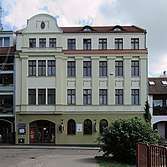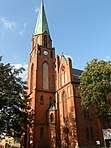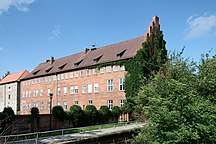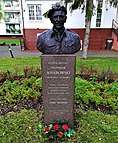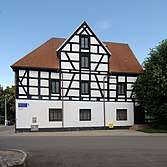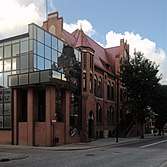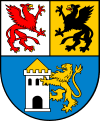Lębork
Lębork ([ˈlɛmbɔrk]; Kashubian: Lãbòrg; German: Lauenburg in Pommern) is a town of 37,000 people on the Łeba and Okalica rivers in the Gdańsk Pomerania region in northwestern Poland. Lębork is also the capital of Lębork County in Pomeranian Voivodeship since 1999, formerly the Słupsk Voivodeship (1975–1998) and Gdańsk Voivodeship (1945-1975).
Lębork | |
|---|---|
s.jpg) Neo-gothic City Hall | |
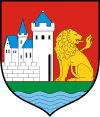 Coat of arms | |
| Motto(s): Miasto z Europejską klasą European style town | |
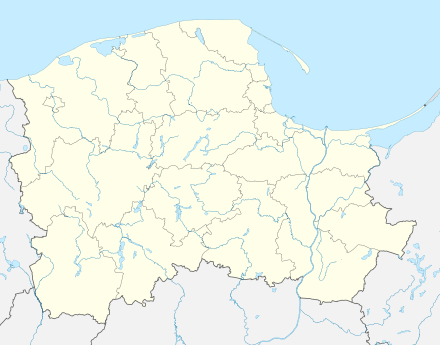 Lębork  Lębork | |
| Coordinates: 54°33′N 17°45′E | |
| Country | |
| Voivodeship | |
| County | Lębork County |
| Gmina | Lębork (urban gmina) |
| Town rights | 1341 |
| Government | |
| • Mayor | Witold Namyślak |
| Area | |
| • Total | 17.86 km2 (6.90 sq mi) |
| Highest elevation | 46 m (151 ft) |
| Lowest elevation | 17 m (56 ft) |
| Population (2006) | |
| • Total | 35,069 |
| • Density | 2,000/km2 (5,100/sq mi) |
| Time zone | UTC+1 (CET) |
| • Summer (DST) | UTC+2 (CEST) |
| Postal code | 84–300 to 84–310 |
| Area code(s) | +48 59 |
| Car plates | GLE |
| Website | http://www.lebork.pl |
History
The town was founded on the site of a previous Polish settlement named Łebno, dating back to the 10th century,[1] Germanised to Lewin and then Lewinburg by the Teutonic Knights,[2][3] after annexation from Poland in 1310.[1] In 1341 Dietrich von Altenburg, Grand Master of the Teutonic Knights, granted 100 Hufen (similar to hides) to Rutcher von Emmerich for the foundation of a town named Lewinburg (Lauenburg) with Kulm rights,[4] presumably to secure the territory around Stolp (Słupsk).[5] East of the original city the Teutonic Order completed the Ordensburg castle in 1363. The castle was partly razed after the 1410 Battle of Grunwald and remained under Polish control until 1411. In 1440 the town joined the Prussian Confederation, which opposed the Teutonic Knights, and at the request of which King Casimir IV Jagiellon signed the act of re-incorporation of the town and region to the Kingdom of Poland in 1454. The population of Lauenburg was composed in large part of Kashubians, later Slovincians.
In 1454 after the outbreak of the Thirteen Years' War, troops from Danzig (Gdańsk) occupied Lauenburg and Bütow (Bytów); the following year they were turned over to Eric II, Duke of Pomerania, to form an alliance.[4] Because Lauenburg remained loyal to the Prussian Confederation and not the Teutonic Order, King Casimir IV Jagiellon of Poland granted the town three nearby villages.[4] Troops from the Polish-allied city of Gdańsk (Danzig) reoccupied Lauenburg in 1459 when the mayor, Lorenz Senftopf, entered into negotiations with the Teutonic Knights. Eric replaced the Danzigers with Teutonic Knights the following year, however, when he switched sides during the war. After the Teutonic Knights were ultimately defeated in the Thirteen Years' War, Lębork passed to Poland, according to the 1466 Second Peace of Thorn,[6] and was granted by Casimir IV Jagiellon to Eric and his Pomeranian successors as part of the Lauenburg and Bütow Land, a Polish fief.
.jpg)
The Protestant Reformation was introduced in the town soon after 1519.[4] The territory came back to Polish King Władysław IV Vasa as a reverted fief and was integrated with the Polish Pomeranian Voivodeship after the 1637 death of Bogislaw XIV, Duke of Pomerania.[6] As Lębork was the leading city of the territory, it became the seat of the eldership (starostwo).[7] The starosts were Stanisław Koniecpolski and Jakub Wejher.[7] The Counter-Reformation was largely ineffective in the Lutheran town. Lębork was occupied by Swedes in the Northern Wars. To gain an ally against Sweden during the Deluge, King John II Casimir of Poland gave the Lauenburg and Bütow Land to Margrave Frederick William of Brandenburg-Prussia as a hereditary fiefdom in the 1657 Treaty of Bromberg. The Swedish troops burnt Lauenburg before their retreat in 1658, destroying seventy houses and the town hall.[4] Frederick William released the town from tax duties for five years to aid in its rebuilding. Lauenburg suffered a second fire in 1682.[6] King John III Sobieski made peaceful attempts to reintegrate the town directly to Poland, but to no avail.[8]
In 1701, Lauenburg/Lębork became a Prussian-administered territory under the sovereignty of the Polish Crown. The 1773 Treaty of Warsaw granted full sovereignty over the territory to Prussia after the First Partition of Poland. The Lauenburg and Bütow Land, transformed into a district (Lauenburg-Bütowscher Kreis), was first included in the newly established province of West Prussia, but was transferred to the province of Pomerania in 1777.
When the district was divided in 1846, Lauenburg became the capital of a new district (Landkreis Lauenburg i. Pom.). Lauenburg began to develop as an industrial center after its 1852 connection to the Prussian Eastern Railway to Danzig and Stettin (Szczecin).[4] In 1866, the Masonic Lodge was formed, whose membership was in the main made up of the elite entrepreneurial class. The building survives to this day. The town became part of the German Empire in 1871 during the unification of Germany. Chancellor Otto Fürst von Bismarck (1815–1898) was made an honorary citizen in 1874. New German settlers came to the town, but Poles also still settled there.[9] Despite Germanisation policies, the Polish-Kashubian movement developed.[10] Helpful in preserving Polish culture and identity was the local Catholic church, in which Polish language lessons were still organized.[11]
Poland regained independence after World War I in 1918, and local Poles organized a pro-Polish rally, which was shut down by the local German police. Polish activists were sentenced to several months in prison, and then to exile.[12] Despite Polish attempts at regaining control of the region, the Treaty of Versailles did not restore the pre-partition borders and the town remained within interwar Germany. In the subsequent years many German migrants resettled in and around Lauenburg,[13] while many Poles, including Kashubians, left for the nearby Polish Pomeranian Voivodeship.[14] The city's economy has declined and the nationalists, communists and Nazis gained popularity among the German population.[15] The Poles were active in the Union of Poles in Germany.[1] After the Nazis took power, Poles, as well as Jews, were persecuted.[16] Under the leadership of Willy Fruggel a Hochschule for teacher education was established in the city in 1933.[13] The football club SV Sturm Lauenburg played within Gauliga Pommern.
After the outbreak of World War II, the persecution of indigenous Poles, including Kashubians, intensified, and the patients of the local psychiatric hospital were murdered in Piaśnica, however, the Polish resistance movement remained present in the district.[17] Lauenburg was also the location of the Nazi concentration camp Lauenburg, a subcamp of Stutthof. The city was occupied without resistance by the Soviet Red Army on 10 March 1945. Most of the Old Town burned in the subsequent Soviet rampage, although the Gothic Church of St. James and the Teutonic castle survived.[13] During this time about 600 people committed suicide.[18]
As Lębork, the town was placed under Polish administration in accordance with the post-war Potsdam Agreement. Germans remaining in the town were either immediately expelled or were allowed to voluntarily leave in the 1950s. New Polish citizens, some of them from Poland's eastern lands annexed after the war by the Soviet Union, took the place of the previous German inhabitants of the town.
Geography
Climate
The climate in this area has mild differences between highs and lows, and there is adequate rainfall year-round. The Köppen Climate Classification subtype for this climate is "Cfb". (Marine West Coast Climate/Oceanic climate).[19]
Demographics
Before the end of World War II the population was predominantly composed of Protestants.
- Number of inhabitants in years
- 1782: 1,482, incl. 36 Jews.[20]
- 1794: 1,432, incl. 29 Jews.[20]
- 1812: 1,548, incl. 48 Catholics and 47 Jews[20]
- 1831: 2,621, incl. 181 Catholics and 147 Jews.[20]
- 1843: 3,779, incl. 222 Catholics and 262 Jews.[20]
- 1861: 5,310, incl. 305 Catholics and 259 Jews.[20]
- 1900: 10,442, incl. 1,151 Catholics and 276 Jews.[21]
- 1910: 13,916
- 1925: 17,161, incl. 1,850 Catholics, 290 Jews and 300 others.[22]
- 1933: 18,962
- 1939: 19,108[13]
- 1960: 21,200
- 1970: 25,100
- 1975: 26,600
- 1980: 29,200
- 1990: 34,300
- 1995: 36,300
- 1998: 37,000
- 2004: 35,154
- 2005: 35,000
Notable residents
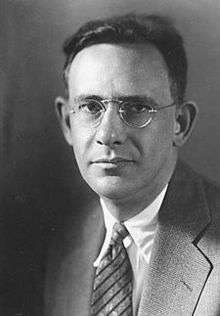
.jpg)
- Julius Friedrich August Bahnsen (1830 – 1881), philosopher, the originator of characterology
- Paul Gottlieb Nipkow (1860–1940) a German technician, television pioneer, invented the Nipkow disk
- Josef Horovitz (1874–1931) a Jewish German orientalist
- Gerhard Obuch (de) (1884–1960), politician and lawyer
- Edward Sapir (1884–1939), ethnologist and linguist
- Erich von dem Bach (1899–1972), SS officer
- Ethel Reschke (1911–1992) a German actress [23]
- Ewa Paradies (1920–46), concentration camp overseer
- Jürgen Echternach (1937–2006) CDU politician
- Hilbert Meyer (de) (born 1941) professor of the science of education in Oldenburg
- Eugeniusz Geno Malkowski (1942–2016), artist and painter
- Peter Roehr (1944–68) a German artist
- Maciej Gołąb (born 1952), professor of musicology
- Anna Fotyga (born 1957) a Polish politician and MEP , former Minister of Foreign Affairs
- Sport
- Zbigniew Zarzycki (born 1948) a former Polish volleyball player, Olympic Champion in 1976
- Zbigniew Kaczmarek (born 1962) a former Polish football player, played 30 times for Poland
- Alexandra Wojcik (born 1985) a Polish group rhythmic gymnast, participated at the 2004 Summer Olympics
- Damian Schulz (born 1990) a Polish volleyball player, member of Poland men's national volleyball team
- Paula Wrońska (born 1991) a Polish sports shooter, competed in the 2012 Summer Olympics
International relations
Lębork is twinned with:
See also
Notes
- "Lębork". Encyklopedia PWN (in Polish). Retrieved 11 February 2020.
- Slavia occidentalis: Tomy 46–47 1991, page 371.
- Słownik etymologiczny miast i gmin PRL Stanisław Rospond – 1984
- Schmidt, 229
- Schmidt, p. 228
- Słownik geograficzny Królestwa Polskiego i innych krajów słowiańskich, Tom V, Warsaw, 1884, p. 199 (in Polish)
- "1637-1658". Historia Bytowa w pigułce (in Polish). Retrieved 11 February 2020.
- Lindemajer & Machura 1982, p. 87.
- Lindemajer & Machura 1982, p. 99-100.
- Lindemajer & Machura 1982, p. 124.
- Lindemajer & Machura 1982, p. 125.
- Lindemajer & Machura 1982, p. 127.
- Schmidt, 230
- Lindemajer & Machura 1982, p. 142.
- Lindemajer & Machura 1982, p. 137-140.
- Lindemajer & Machura 1982, p. 140-142.
- Lindemajer & Machura 1982, p. 163-164.
- Lakotta, Beate (2005-03-05). "Tief vergraben, nicht dran rühren" (in German). SPON. Retrieved 2010-08-16.
- Climate Summary for Lebork, Poland
- Kratz, p. 250
- Meyers Konversations-Lexikon. 6th edition, vol. 12, Leipzig and Vienna 1908, p. 241 (in German).
- Der Große Brockhaus. 15th edition, vol. 11, Leipzig 1932, p. 170 (in German).
- IMDb Database retrieved 8 November 2018
References
- Schmidt, Roderich (1996). Handbuch der historischen Stätten Deutschlands, Band 12, Mecklenburg/Pommern. Stuttgart: Alfred Kröner Verlag. p. 388. ISBN 3-520-31501-7. (in German)
- Gustav Kratz: Die Städte der Provinz Pommern – Abriss ihrer Geschichte, zumeist nach Urkunden (The towns of the Province of Pomerania – Sketch of their history, mostly according to historical records). Berlin 1865 (reprinted in 2010 by Kessinger Publishing, ISBN 1-161-12969-3), pp. 247–251 (in German, online)
- Lindemajer, Józef; Machura, Teresa (1982). Dzieje Lęborka (in Polish). Poznań: Wydawnictwo Poznańskie.CS1 maint: ref=harv (link)

